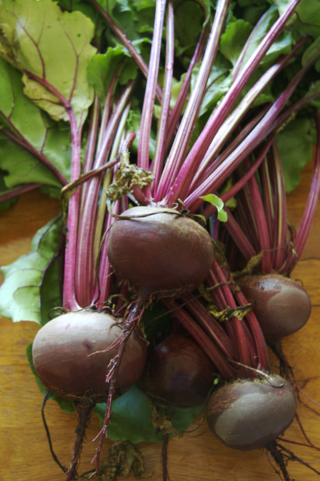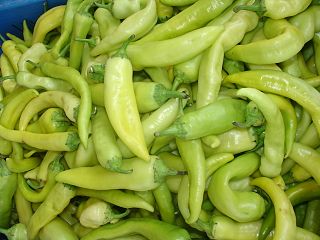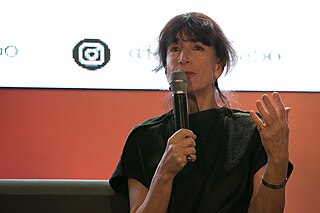Related Research Articles

Forest gardening is a low-maintenance, sustainable, plant-based food production and agroforestry system based on woodland ecosystems, incorporating fruit and nut trees, shrubs, herbs, vines and perennial vegetables which have yields directly useful to humans. Making use of companion planting, these can be intermixed to grow in a succession of layers to build a woodland habitat. Forest gardening is a prehistoric method of securing food in tropical areas. In the 1980s, Robert Hart coined the term "forest gardening" after adapting the principles and applying them to temperate climates.

The beetroot is the taproot portion of a beet plant, usually known in North America as beets while the vegetable is referred to as beetroot in British English, and also known as the table beet, garden beet, red beet, dinner beet or golden beet.

The New York Botanical Garden (NYBG) is a botanical garden at Bronx Park in the Bronx, New York City. Established in 1891, it is located on a 250-acre (100 ha) site that contains a landscape with over one million living plants; the Enid A. Haupt Conservatory, a greenhouse containing several habitats; and the LuEsther T. Mertz Library, which contains one of the world's largest collections of botany-related texts. As of 2016, over a million people visit the New York Botanical Garden annually.

Green beans are young, unripe fruits of various cultivars of the common bean, although immature or young pods of the runner bean, yardlong bean, and hyacinth bean are used in a similar way. Green beans are known by many common names, including French beans, string beans, and snap beans or simply "snaps." In the Philippines, they are also known as "Baguio beans" or "habichuelas" to distinguish them from yardlong beans.

Tatsoi is an Asian variety of Brassica rapa grown for greens. Also called tat choy, it is closely related to the more familiar bok choy. This plant has become popular in North American cuisine as well, and is now grown throughout the world.

The banana pepper is a medium-sized member of the chili pepper family that has a mild, tangy taste. While typically bright yellow, it is possible for them to change to green, red, or orange as they ripen. It is often pickled, stuffed or used as a raw ingredient in foods. It is a cultivar of the species Capsicum annuum. Its flavor is not very hot and, as is the case with most peppers, its heat depends on the maturity of the pepper, with the ripest being sweeter than younger ones.
Maureen Theresa Howard was an American novelist, memoirist, and editor. Her award-winning novels feature women protagonists and are known for formal innovation and a focus on the Irish-American experience.

Amy Goldman Fowler is an American billionaire heiress, gardener, author, artist, philanthropist, and advocate for seed saving and heirloom fruits and vegetables. She is one of the foremost heirloom plant conservationists in the US. Goldman has been called "perhaps the world's premier vegetable gardener" by Gregory Long, president emeritus of The New York Botanical Garden.
Michelle Stuart is an American multidisciplinary artist known for her sculpture, painting and environmental art. She is based in New York City.

The Felix M. Warburg House is a mansion located on 1109 Fifth Avenue and 92nd Street on the Upper East Side of Manhattan in New York City. The house was built from 1907 to 1908 for the German-American Jewish financier Felix M. Warburg and his family. After Warburg's death in 1937, his widow sold the mansion to a real estate developer. When plans to replace the mansion with luxury apartments fell through, the Warburgs donated it in 1944 to the Jewish Theological Seminary of America. In 1947, the Seminary opened the Jewish Museum of New York in the mansion. The house was named a New York City designated landmark in 1981 and was added to the National Register of Historic Places in 1982.
Maggie Campbell-Culver is a garden and plant historian, and a Fellow of The Linnean Society of London.

The LuEsther T. Mertz Library is located at the New York Botanical Garden (NYBG) in the Bronx, New York City. Founded in 1899 and renamed in the 1990s for LuEsther Mertz, it is the United States' largest botanical research library, and the first library whose collection focused exclusively on botany.

Foodscaping is a modern term for the practice of integrating edible plants into ornamental landscapes. It is also referred to as edible landscaping and has been described as a crossbreed between landscaping and farming. As an ideology, foodscaping aims to show that edible plants are not only consumable but can also be appreciated for their aesthetic qualities. Foodscaping spaces are seen as multi-functional landscapes which are visually attractive and also provide edible returns. Foodscaping is a great way to provide fresh food in an affordable way.
Kay Sekimachi is an American fiber artist and weaver, best known for her three-dimensional woven monofilament hangings as well as her intricate baskets and bowls.

Jessica B. Harris is an American culinary historian, college professor, cookbook author and journalist. She is professor emerita at Queens College, City University of New York, where she taught for 50 years, and is also the author of 15 books, including cookbooks, non-fiction food writing and memoir. She has twice won James Beard Foundation Awards, including for Lifetime Achievement in 2020, and her book High on the Hog was adapted in 2021 as a four-part Netflix series by the same name.
Gail Skoff is a photographer known for her handcolored prints. Much of her work focuses on landscapes and food. She was a 1976 recipient of a fellowship from the National Endowment for the Arts, and several of the prints resulting from fellowship are held by the Smithsonian American Art Museum. Her works are also held at the Biblioteque Nationale in Paris, the Center for Creative Photography in Tucson, and the Oakland Museum of California.

Judith Thurman is an American writer, biographer, and critic. She is the recipient of the 1983 National Book Award for nonfiction for her biography Isak Dinesen: The Life of a Storyteller. Her book Secrets of the Flesh: A Life of Colette was a finalist for the 1999 nonfiction National Book Award. In 2016, she received the medal of Chevalier of the Order of Arts and Letters.

Marion Rombauer Becker was an illustrator, author, environmentalist, and arts administrator. She is best known for her work illustrating the original The Joy of Cooking, which she co-authored with her mother Irma von Starkloff Rombauer, and continued to update after her mother's death.
Jonell Nash was a food editor for Essence from 1984 to 2008 and author of the cookbook Low-Fat Soul, published in 1996.

Gertrude Divine Webster was an American philanthropist known for co-founding the Desert Botanical Garden in Phoenix, Arizona, and establishing Yester House, her summer estate which is on the National Register of Historic Places and houses the Southern Vermont Arts Center. During her marriage to William McClellan Ritter she was known as Gertrude Divine Ritter. She subsequently married Hugh Webster, and was known as Gertrude Divine Webster until her death on March 31, 1947.
References
- 1 2 3 4 Sims, Judith (February 25, 1989). "A Walk in the Garden With Pioneer of Edible Landscape". Los Angeles Times. Retrieved November 24, 2022.
- ↑ Faust, Joan Lee (April 11, 1982). "Around the Garden". The New York Times. ISSN 0362-4331 . Retrieved November 24, 2022.
- ↑ George, Aleta (November 3, 2010). "Rosalind Creasy's garden won't let you grow hungry". SFGATE. Retrieved November 24, 2022.
- ↑ Green, Emily (July 27, 2002). "Eat what you sow". Journal and Courier. p. 26. Retrieved November 24, 2022.
- ↑ James, Mary (March 17, 2012). "Edible landscape pioneer advocates herb-scaping". San Diego Union-Tribune. Retrieved November 24, 2022.
- ↑ Jenkins, Nancy Harmon (May 30, 1990). "COOKS ON THE MAP; This Month: Rosalind Creasy, Los Altos, Calif.; Where a Front Yard Is Part of the Pantry". The New York Times. ISSN 0362-4331 . Retrieved November 24, 2022.
- ↑ "Flower cookery". The Daily Oklahoman. April 10, 1991. p. 9. Retrieved November 24, 2022.
- ↑ Arrington, Debbie (November 6, 2010). "A garden of bounty". The Sacramento Bee. pp. , . Retrieved November 24, 2022.
- ↑ Szerlag, Nancy (September 4, 1999). "Gardening: Fall resembles a season of reflection, a time to ponder changes". Detroit News; Detroit, Mich. [Detroit, Mich]. pp. D6 – via ProQuest.
- ↑ "GardenComm | Honors & Awards | Hall of Fame". gardencomm.org. Retrieved November 24, 2022.
- ↑ Review of The Complete Book of Edible Landscaping
- Faust, Joan Lee (April 11, 1982). "Around the Garden". The New York Times. ISSN 0362-4331 . Retrieved November 24, 2022.
- ↑ Review of Edible Landscaping
- Sterman, Nan (November 9, 2010). Rosalind Creasy's new 'Edible Landscaping' . Retrieved November 24, 2022.
{{cite book}}:|website=ignored (help)
- Sterman, Nan (November 9, 2010). Rosalind Creasy's new 'Edible Landscaping' . Retrieved November 24, 2022.
- ↑ Review of The Edible Flower Garden
- "Review of The Edible Garden Series". www.forewordreviews.com. Retrieved November 24, 2022.
- ↑ Review of The Edible Heirloom Garden
- Ogden, Ellen (2021). The new heirloom garden : designs, recipes, and heirloom plants for cooks who love to garden. Matthew Benson (First ed.). New York, NY. ISBN 978-1-63565-083-9. OCLC 1232480707.
{{cite book}}: CS1 maint: location missing publisher (link)
- Ogden, Ellen (2021). The new heirloom garden : designs, recipes, and heirloom plants for cooks who love to garden. Matthew Benson (First ed.). New York, NY. ISBN 978-1-63565-083-9. OCLC 1232480707.
- ↑ Review of Cooking from the Garden
- Jenkins, Nancy Harmon (March 29, 1989). "Books for Cooks and Stove-Top Travelers". The New York Times. ISSN 0362-4331 . Retrieved November 24, 2022.